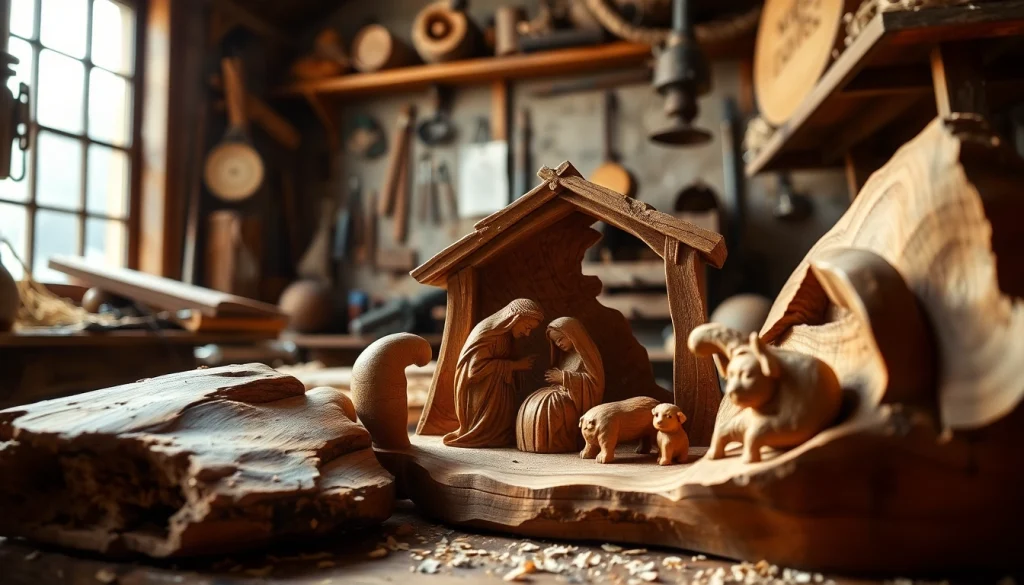
Understanding Olive Wood Carvings
What are Olive Wood Carvings?
Olive wood carvings represent a unique and culturally rich art form that involves the transformation of olive wood into intricate sculptures, religious icons, and decorative pieces. These items are predominantly sourced from olive trees, which are historically significant in regions like the Mediterranean, particularly in places like Palestine and Israel. The wood is prized for its beautiful grain, durability, and natural patterns that emerge during the carving process. Typically, artisans use traditional techniques to create everything from intricate nativity scenes to small figurines, ensuring that each piece is not only a work of art but also a reflection of the region’s cultural and spiritual heritage. Olive wood carvings come deeply imbued with meaning, often serving both aesthetic and spiritual purposes.
The Significance of Olive Wood in Art
Olive wood holds significant cultural and emotional weight, especially within the Christian tradition. The olive tree is often considered a symbol of peace, hope, and reconciliation, making olive wood carvings particularly valued in religious contexts. Each piece tells a story, reflecting centuries of tradition and the pivotal role that olive wood plays in the community’s spiritual life. The carving of olive wood is much more than just a craft; it serves as a connection to history and faith, making these pieces cherished heirlooms that can be passed down through generations.
Traditional Techniques Used in Carving
Artisans employ a variety of traditional techniques when carving olive wood. This craftsmanship is often passed down through generations, allowing for the preservation of age-old methods while also encouraging personal innovation. The techniques include hand chiseling, sanding, and polishing, often combined with natural oils to enhance the wood’s aesthetic appeal and preserve its longevity. The careful selection and preparation of the wood are crucial; artisans select only the finest sections of the tree, often using wood from pruned branches rather than cutting down trees, which aligns with sustainable practices. This craftsmanship not only contributes to the beauty of the carvings but also preserves the integrity and value of the wood itself.
The Cultural Heritage of Olive Wood Carvings
Historical Background of Olive Wood Carving
The art of olive wood carving has roots stretching back thousands of years. From ancient civilizations that utilized olive wood for everyday items and tools to its evolution into a medium for religious and decorative art forms, this craft has been deeply intertwined with the cultural and spiritual lineage of its regions. The production of olive wood carvings gained prominence with the rise of Christianity in the Holy Land, where artisans began carving pieces that depicted biblical narratives, saints, and significant religious events, thereby creating a vital connection between faith and artistic expression.
Olive Wood Carvings in Religious Contexts
In various religious traditions, particularly Christianity, olive wood carvings play a significant role in worship and personal devotion. Nativity scenes, crosses, and figures of saints crafted from olive wood serve not only as focal points for prayer and reflection but also as tangible representations of faith. These creations are often displayed in homes, churches, and galleries, reminding individuals of their spirituality and cultural heritage. Furthermore, the utilization of olive wood in religious contexts helps support local artisans, embedding their cultural narratives within the global community of faith.
The Role of Artisans in Preserving Tradition
Artisans are the custodians of the olive wood carving tradition, ensuring the techniques, materials, and cultural stories are not lost to time. Many artisans work in family-run workshops, where knowledge is shared orally and through demonstration, creating a vibrant community of craftspeople. Their commitment to quality and authenticity preserves not just their craft but also the cultural identity of their community, allowing them to thrive economically while sustaining their traditions. As globalization puts pressure on local economies, supporting these artisans becomes ever more critical to upholding the rich tapestry of cultural heritages that olive wood carving represents.
How to Choose the Perfect Olive Wood Carving
Factors to Consider When Selecting Carvings
When choosing olive wood carvings, consider the purpose of the piece—whether it is for decorative use, a gift, or personal significance. The size, style, and subject matter should resonate with your taste and the intended use. Additionally, it is essential to assess the craftsmanship; well-crafted pieces should have smooth finishes and intricate details that reflect the care that went into their creation. The price may also reflect the artisan’s expertise and the time invested in producing the carving.
Evaluating Craftsmanship and Quality
Quality craftsmanship is a hallmark of authentic olive wood carvings. To gauge quality, inspect the intricacy of the carving itself; well-defined details indicate a skilled hand. Look for a smooth finish and a natural shine that emanates from the wood’s surface, suggesting the application of protective oils. An authentic piece should also have a natural grain, highlighting the unique patterns that occur in olive wood. Genuine pieces typically bear the mark of the artisan or workshop, which can further authenticate the work.
Understanding Different Styles and Designs
The world of olive wood carving is diverse, with varying styles influenced by culture, tradition, and the prevailing artistic trends of the time. From traditional religious figures to contemporary designs, recognizing styles can help you find a piece that truly reflects your taste. For instance, traditional pieces may showcase biblical themes and figures, while more modern designs might explore abstract shapes or minimalist aesthetics. Understanding these styles can enrich the selection process and enhance the appreciation for the artistry involved.
Caring for Your Olive Wood Carvings
Maintenance Tips for Longevity
To ensure the longevity of your olive wood carvings, regular maintenance is crucial. Keep your carvings in a stable environment, avoiding direct sunlight and extreme humidity, which can cause the wood to warp or crack. Dust your carvings gently with a soft cloth, taking care not to scratch the surface. If the wood begins to look dull, consider applying a small amount of mineral oil or specialized wood treatment to restore its luster. These simple steps can greatly extend the life of your cherished pieces.
Cleaning and Storage Best Practices
Cleaning olive wood carvings should be approached with care. Use a damp cloth for general cleaning—avoid soaking the wood in water, as this can lead to damage. For more thorough cleanings, a mild soap solution can be used, but ensure that all moisture is removed promptly afterward. When storing your carvings, place them in a dry area, preferably in a felt-lined box to prevent scratches and moisture accumulation. If you have larger pieces, consider displaying them in a way that reduces exposure to dust while allowing visibility.
Restoring Worn or Damaged Carvings
Even with proper care, olive wood carvings can become worn over time. To restore a carving, begin by cleaning it gently to remove any dirt or residue. If the wood has lost its sheen, consider sanding it lightly with fine-grit sandpaper followed by the application of mineral oil. For more significant damages, involving cracks or chips, you may need to consult a professional restorer who specializes in woodwork. Addressing these issues early ensures that your olive wood carvings remain beautiful and enduring pieces of art.
Where to Find Authentic Olive Wood Carvings
Online vs. Local Artisans
When searching for authentic olive wood carvings, you have the option of purchasing online or visiting local artisans. Online marketplaces provide a broad selection, often featuring detailed descriptions and photographs to assist in your decision-making. However, purchasing directly from local artisans offers the benefit of supporting their craft and often guarantees authenticity. Consider both avenues to find pieces that resonate with you, but prioritize supporting local artists when feasible.
Fair Trade and Ethical Considerations
As a consumer, it is essential to consider the ethical implications of your purchases. Look for artisans who adhere to fair trade principles, ensuring that the creators receive equitable compensation for their work. This practice fosters sustainable economic development within the community and helps preserve the cultural heritage associated with olive wood carving. By choosing to purchase fair trade products, you not only support local artisans but also contribute to the resilience of their crafts.
Supporting Local Communities Through Purchase
Purchasing olive wood carvings can significantly impact the local communities from which they originate. By investing in their art, you help sustain their livelihoods and ensure the continuation of generational techniques and traditions. This support goes beyond mere transactions; it fosters a relationship between the consumer and artisan, preserving not only the craft itself but the stories and cultural significance tied to the pieces. Ultimately, this collective support can lead to a richer appreciation of the artistry of olive wood carvings.





